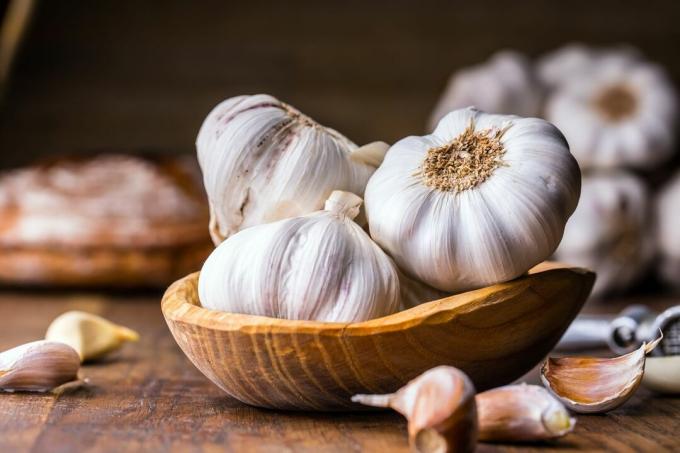Garlic is a must when cooking. We show tips and tricks for growing in your own garden, suitable varieties and for harvesting and storage.

Anyone who likes to cook can hardly avoid garlic (Allium sativum). While the supermarket goods sometimes cover enormous distances before the tuber finally ends up in our kitchen, the plant can be grown in the garden without any problems. Garlic is also considered to be very healthy and has already been voted medicinal plant of the year.
Originally native to Central Asia and Persia, garlic spread quickly and is now cultivated in many countries around the world. Cultivated for centuries, wild garlic plants already exist in a number of countries.
Synonyms: knucklehead,Chnobli (CH), garlic
contents
- Growing garlic in the garden
- Garlic Varieties: A manageable selection
- Harvesting, drying and storage of garlic
- Ingredients and use in the kitchen
- Diseases and pests in garlic cultivation
Growing garlic in the garden
Garlic is easy to grow in your own garden. If you have no space in the bed, you can also cultivate them in larger flower pots. Garlic gets along very well with tomatoes and can be cultivated together with them in the pots, preferably with garlic mixed cultures beforehand. Garlic feels most comfortable in a sunny location with loose, slightly moist soil. Waterlogging should be avoided at all costs.
A few cloves of garlic are planted 15-20 cm apart at a depth of 3-4 cm, preferably in autumn, but also in spring. The row spacing should be about 30 cm. Even if garlic only grows slowly at first, the fertilization must be weighed up: Nitrogen additions promote the yield, but dilute the taste. In our experience, a good basic fertilization with compost has proven to be very effective. If garlic is over-fertilized, it is difficult to store and begins to rot early. On dry summer days, the garlic needs a little watering. Regular watering is otherwise not necessary.
Detailed instructions can be found here: Planting, caring for & harvesting garlic.
Garlic Varieties: A manageable selection
Although there are countless varieties of garlic for commercial cultivation, it has found its way onto the shelves of seed and seed suppliers. Very few managed onions: Arno, Rosa and Vivalto are three examples. In general, a distinction is made between normal garlic and chives. At the latter, the green is harvested and processed.
If you want to know more about the varieties, take a look here: Garlic varieties: the best 20 at a glance.
- Arno: Well-growing garlic variety with a good yield and a white outer skin.
- Fat Leaf: With this variety you do not harvest the tubers, but the green leaves. This type of garlic is therefore known as chives.
- neko: Vigorous chives with a good aroma; less intense garlic flavor.
- pink: High-yielding variety with an intensely colored outer skin.
- Vivalto: High-yielding garlic variety with a slightly pink colored outer skin; easy and robust in cultivation.

Harvesting, drying and storage of garlic
It is harvested in autumn, when the top third of the plant begins to wither. When digging up, care should be taken not to damage the tubers. This is a gateway for pathogens that often cause the tuber to rot. If the weather is dry, the freshly harvested garlic is first left to dry on the bed. Then you can braid the plants into a braid or hang them individually in a covered and airy place. Well-dried garlic has a long shelf life.
It is best to choose a cool, dry and dark place for storage. Garlic should not be stored in the refrigerator. It is too cool here and moisture is also removed from the tuber. The aroma is lost after a few days. Some people cut the garlic into small cubes and slowly dry them in the oven. Taste is lost here, but the end result is still acceptable for drying. Soaking in olive oil (optional) with some chili and rosemary) is one way to get the great garlic aroma.
You can find even more information in our special article on Harvesting and storing garlic.

Ingredients and use in the kitchen
In particular, the sulphur-containing secondary plant substances such as alliin are responsible for the typical garlic smell. However, it is precisely these substances that are also said to have an antibacterial effect. Potassium and phosphates are two of the minerals it contains. Researchers disagree on the effects attributed to garlic. Some studies show a positive influence on blood pressure, cholesterol levels and blood fat, but there are also studies that contradict these results.
Nevertheless, garlic is very tasty and should not be missing from Mediterranean and Asian dishes. When frying, however, you should be careful that the temperatures are not too high and the garlic does not get too dark. Because then it tastes bitter.
Diseases and pests in garlic cultivation
Garlic is one of the few plants that grow in the garden with ease. Once planted, with the exception of watering in midsummer, you can sit back and relax and wait for the harvest. In very rainy years, the tubers can already rot in the bed. The same occurs at locations with waterlogging. In commercial cultivation there is now and then garlic rust, which is why farmers should also pay close attention to crop rotation.



